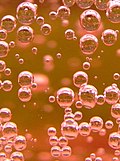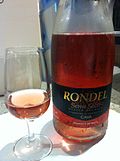Sparkling wine
Sparkling wine is a type of wine that contains significant levels of carbon dioxide in it, making it fizzy. The carbon dioxide may result from natural fermentation, either in a bottle, as with the méthode champenoise, in a large tank designed to withstand the pressures involved (as in the Charmat process), or as a result of carbon dioxide injection.
Sparkling wine is usually white wine or rosé, but there are many examples of red sparkling wine such as Italian Brachetto and Australian sparkling Shiraz. The sweetness of sparkling wine can range from very dry "brut" styles to sweeter "doux" varieties.
The classic example of a sparkling wine is Champagne, but many other examples are produced in other countries and regions, such as Cava in Spain, Italian Prosecco, and Cap Classique in South Africa. Most countries reserve the word Champagne to only be used if the sparkling wine is produced in the Champagne region of France. In the EU countries and the US, this legal protection is enforced. In other countries such as Australia, South Africa and Chile, it is legal to label any sparkling wine as Champagne.
Production[edit]
Sparkling wine is produced by two main methods: the traditional méthode champenoise and the Charmat process. The former, used in Champagne, involves secondary fermentation in the bottle, while the latter ferments in a large tank.
Types of sparkling wine[edit]
There are many different types of sparkling wine produced around the world. These include:
- Champagne: Produced in the Champagne region of France using the traditional method.
- Cava: A Spanish sparkling wine that can be white or rosé.
- Prosecco: An Italian sparkling wine, generally dry or extra dry.
- Sekt: A German sparkling wine, usually fully sparkling and dry.
- Cap Classique: A South African sparkling wine made using the traditional method.
See also[edit]
Ad. Transform your life with W8MD's Budget GLP-1 injections from $75


W8MD offers a medical weight loss program to lose weight in Philadelphia. Our physician-supervised medical weight loss provides:
- Weight loss injections in NYC (generic and brand names):
- Zepbound / Mounjaro, Wegovy / Ozempic, Saxenda
- Most insurances accepted or discounted self-pay rates. We will obtain insurance prior authorizations if needed.
- Generic GLP1 weight loss injections from $75 for the starting dose.
- Also offer prescription weight loss medications including Phentermine, Qsymia, Diethylpropion, Contrave etc.
NYC weight loss doctor appointmentsNYC weight loss doctor appointments
Start your NYC weight loss journey today at our NYC medical weight loss and Philadelphia medical weight loss clinics.
- Call 718-946-5500 to lose weight in NYC or for medical weight loss in Philadelphia 215-676-2334.
- Tags:NYC medical weight loss, Philadelphia lose weight Zepbound NYC, Budget GLP1 weight loss injections, Wegovy Philadelphia, Wegovy NYC, Philadelphia medical weight loss, Brookly weight loss and Wegovy NYC
|
WikiMD's Wellness Encyclopedia |
| Let Food Be Thy Medicine Medicine Thy Food - Hippocrates |
Medical Disclaimer: WikiMD is not a substitute for professional medical advice. The information on WikiMD is provided as an information resource only, may be incorrect, outdated or misleading, and is not to be used or relied on for any diagnostic or treatment purposes. Please consult your health care provider before making any healthcare decisions or for guidance about a specific medical condition. WikiMD expressly disclaims responsibility, and shall have no liability, for any damages, loss, injury, or liability whatsoever suffered as a result of your reliance on the information contained in this site. By visiting this site you agree to the foregoing terms and conditions, which may from time to time be changed or supplemented by WikiMD. If you do not agree to the foregoing terms and conditions, you should not enter or use this site. See full disclaimer.
Credits:Most images are courtesy of Wikimedia commons, and templates, categories Wikipedia, licensed under CC BY SA or similar.
Translate this page: - East Asian
中文,
日本,
한국어,
South Asian
हिन्दी,
தமிழ்,
తెలుగు,
Urdu,
ಕನ್ನಡ,
Southeast Asian
Indonesian,
Vietnamese,
Thai,
မြန်မာဘာသာ,
বাংলা
European
español,
Deutsch,
français,
Greek,
português do Brasil,
polski,
română,
русский,
Nederlands,
norsk,
svenska,
suomi,
Italian
Middle Eastern & African
عربى,
Turkish,
Persian,
Hebrew,
Afrikaans,
isiZulu,
Kiswahili,
Other
Bulgarian,
Hungarian,
Czech,
Swedish,
മലയാളം,
मराठी,
ਪੰਜਾਬੀ,
ગુજરાતી,
Portuguese,
Ukrainian














